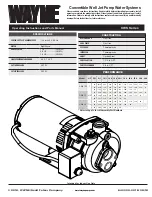
D-303371 GB-501 PG2 Installation Instructions
1
GB
GB
GB
GB----501 PG2
501 PG2
501 PG2
501 PG2
Wireless PowerG Two-way Glass-break Detector
Installation Instructions
1. INTRODUCTION
1. INTRODUCTION
1. INTRODUCTION
1. INTRODUCTION
The GB-501 PG2 is a wireless PowerG Two-way Glass-break detector designed to detect the breaking of framed glass mounted in an outside
wall.
The GB-501 PG2 combines two modules:
•
The Sentrol Inc. ShatterPro™ acoustic sensor with Pattern Recognition Technology™ (Protected under U.S. Patent 5,192,931)
•
The Visonic Ltd. MC-302 PG2 transmitter
A
B
A.
Microphone
B.
Detection indicator
Figure 1.
General View
B
A
A.
PowerG transmitter module
B.
Acoustic sensor module
Figure 2.
Module Identification
1.1 Acoustic Sensor
The acoustic sensor module of the GB-501 PG2 is omni-directional, providing 360° coverage. Coverage is measured from the sensor to the point
on the glass farthest from the sensor (see Fig. 3). The sensor can be mounted as close as 1 m (3.3 ft) from the glass.
Figure 3.
Typical Range Measurement
When mounted on opposite wall or adjoining walls, the range is 6 m (20 ft) for plate, tempered, laminated and wired glass.
When mounted on the ceiling, the maximum range is 6 m (20 ft) for plate, tempered, laminated and wired glass
For armor-coated glass, mount the sensor no more than 3.65 m (12 ft) from the glass.
1.2 PowerG Transmitter
The acoustic sensor shares its housing with a miniature transmitter
using PowerG 2-way communications protoco
l.
Upon alarm (glass break detection), a digital message is transmitted, composed of the PowerG ID followed by various status and message-type
markers. Alarm and other data are thus forwarded to the wireless alarm control panel.
The GB-501 PG2 is protected by a front tamper switch and back tamper switch that is activated when the cover is removed or when the base is
forcibly detached from the wall. In a tamper situation, a message is transmitted with the “tamper alert” marker ON.
A periodic supervision message, distinguished by a specific marker, is transmitted automatically. The wireless control panel is thus informed, at
regular intervals, of the sensor’s active participation in the system.
A red LED mounted on the transmitter PCB (visible only when the cover is off) lights whenever alarm or tamper events are reported. The LED
does not light while a supervision message is being transmitted.
2
2
2
2. INSTALLATION
. INSTALLATION
. INSTALLATION
. INSTALLATION
2.1 Optimizing Detection and Avoiding False Alarms
For best detection, avoid installing in:
Rooms with lined, insulating, or sound deadening drapes.
Rooms with closed wooden window shutters inside.
For best false alarm immunity:
Avoid 24-hour loop applications (perimeter loop OK).
Don't use where white noise, such as air compressor noise, is present (a blast of compressed air may cause a false alarm).
Avoid rooms smaller than 3 x 3 m (10 x 10 ft) and rooms with multiple noise sources such as small kitchens, glass booths noisy areas,
garages, small bathrooms, etc.
























